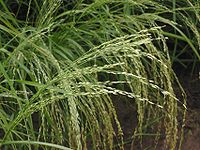
Photo from wikipedia
Eragrostis tef (Zucc.) Trotter (tef) is a small annual grain, panicle-bearing, C4 cereal crop native to Ethiopia, where it is a major staple food. The objectives of the present study… Click to show full abstract
Eragrostis tef (Zucc.) Trotter (tef) is a small annual grain, panicle-bearing, C4 cereal crop native to Ethiopia, where it is a major staple food. The objectives of the present study were to characterize the responses of two tef genotypes to escalating nitrogen (N) levels in terms of shoot, root, and grain biomass production, N concentration and uptake, and to determine an optimum N range at which tef performance is maximized. The N was applied in the irrigation water (Fertigation) in order to provide a consistent concentration of N in the root zone. A second goal was to test the feasibility of growing tef in the hot, arid conditions of the Northern Negev Desert. Two experiments were carried out in the Gilat Research Station (Negev region, Israel), each testing two different genotypes of tef (405B and 406W), and each including five replicates for each treatment. In the winter of 2015–2016, tef plants were grown in perlite filled pots in a walk-in plastic-covered tunnel. Five different N treatments were applied through fertigation, meaning the fertilizer was applied with the irrigation water (10, 20, 40, 80, 120 mg L−1). All other nutrients were applied at the same sufficient rate. In the summer of 2016, tef plots were sown in open-field and applied with four different rates of N fertilization (0, 30, 60, 120 mg L−1). Biomass of the different plant parts, SPAD values, N, P and K concentration, and the lodging index were recorded in each experiment. The harvest index was also calculated. Optimum N fertigation concentration in both experiments was between 40 and 80 mg L−1, under which the time to flowering was decreased, and yield and grain protein concentration were optimized. Underfertilization caused a decrease in overall plant growth, whereas overfertilization caused an increase in vegetative growth at the expense of grain yield. Potassium uptake increased along with increased N availability, whereas P uptake did not. The fertilization rate will always need to take into account local soil and climate conditions. The field experiment also pointed to low harvest index as a major limitation on tef cultivation in the Northern Negev.
Journal Title: Agronomy
Year Published: 2020
Link to full text (if available)
Share on Social Media: Sign Up to like & get
recommendations!